Trek Preparation
Trek Fitness
To ensure your horse will withstand the rigours of a multi-day trek in testing terrain, it’s important to undertake sensible conditioning and fitness in the lead up. It is recommended to have a 6 weeks’ build-up, riding 4–6 days a week.
Week 1 Walking, up to 45 mins ideally on roads or firm terrain to build bone strength and condition tendons and ligaments.
Week 2 Walking and slow trotting 1 –1 ½ hours. Road verges, forest etc.
Week 3. Introduce some hill work at the walk 2 days a week, and longer periods of trotting.
Week 4. Introduce some longer rides up to 3 hours over varying terrain, 1–2 times a week, in between other fitness work.
Week 5. Start some longer day treks and also introduce some uphill trotting and short canters. This will allow you to review your horse’s soundness, fitness and breathing. Monitor their weight and balance feed to accommodate the additional work.
Week 6. Do a good day ride on the hills or an overnight trip.


Checking your Gear Works
A good day/weekend ride gives you a chance to assess how your saddle is working, using your pack gear and making sure there is no slippage of your saddle up and down hills before you head out.
Some horses require a crupper and good breastplate to ensure saddles don’t move around on ascents and descents.
A good breastplate is a good idea even if your saddle doesn’t move. It helps stabilise front packs and stops them bouncing and swinging round.
Saddle Fit
Your saddle should spread weight evenly on the horse’s back to prevent back issues.
When you first get your horse into work, getting your saddle checked is a priority. It may have packed down unevenly last year, or your horse may have changed shape and require the packing to be adjusted to suit. It’s very false economy to not take care of the main item that makes you and your horse’s experiences good ones.
A basic check is sit the saddle on the horse’s bare back. Push alternately on pommel and cantle and see if the saddle rocks. This will give the horse a sore back very quickly as it means most of the weight bearing is in the middle, and the saddle will twist and rotate on this point, plus make the saddle very unstable riding down hills.

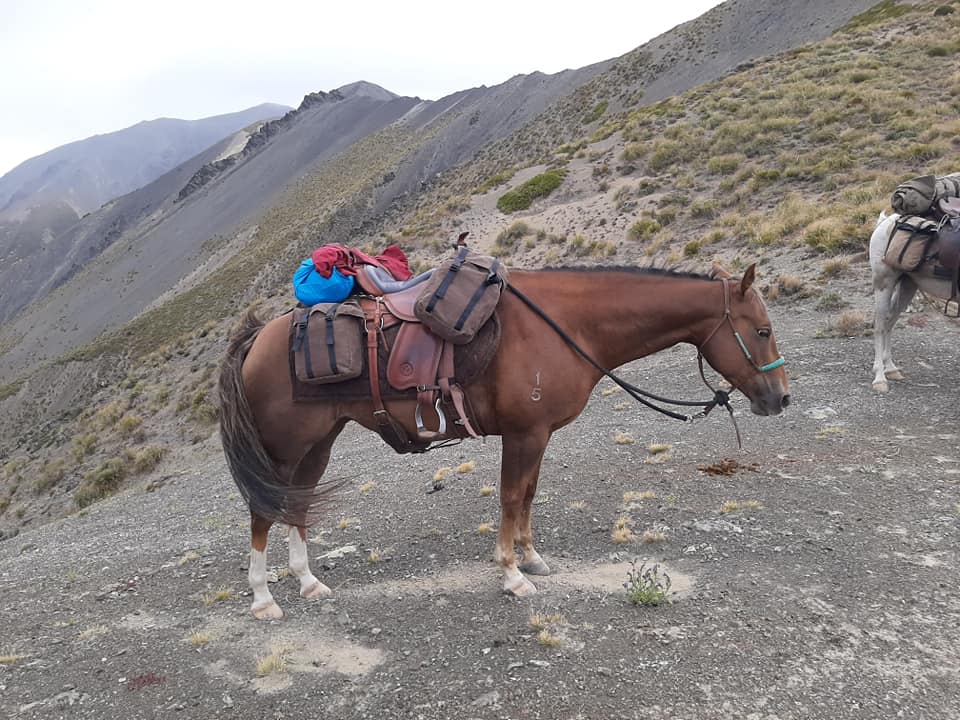
Saddle Fit Cont...
A saddler may be able to adjust the gullet to support the front of the saddle better. If there is no rocking evident, slip your flat hand up under the middle of the seat and feel if there is any gap between packing and the horse’s back (bridging).
If there is, it means the weight of the rider is only supported on four small areas: back of the shoulders and under your bum.This is not ideal especially if you aren’t a featherweight. A saddler can fix this by moving some packing to the centre or reflocking.
Saddle Blankets and Pads
Once you are sure your saddle is a good fit, a good contoured natural fibre blanket is highly recommended. Avoid synthetic pads or ones of quilted dacron. These are very heating and will chafe or blister easier than natural fibre.
An inexpensive trekking pad can be a good wool blanket folded in four. Consider purchasing a Waione Woollies felted pad or similar brand: these are a great investment. Felted wool is very horse friendly and lasts a long time.
A “half pad” of natural fibre (cotton, jute) or wool blanket can be used to keep your expensive pad clean, and it will dry quicker overnight on long treks.

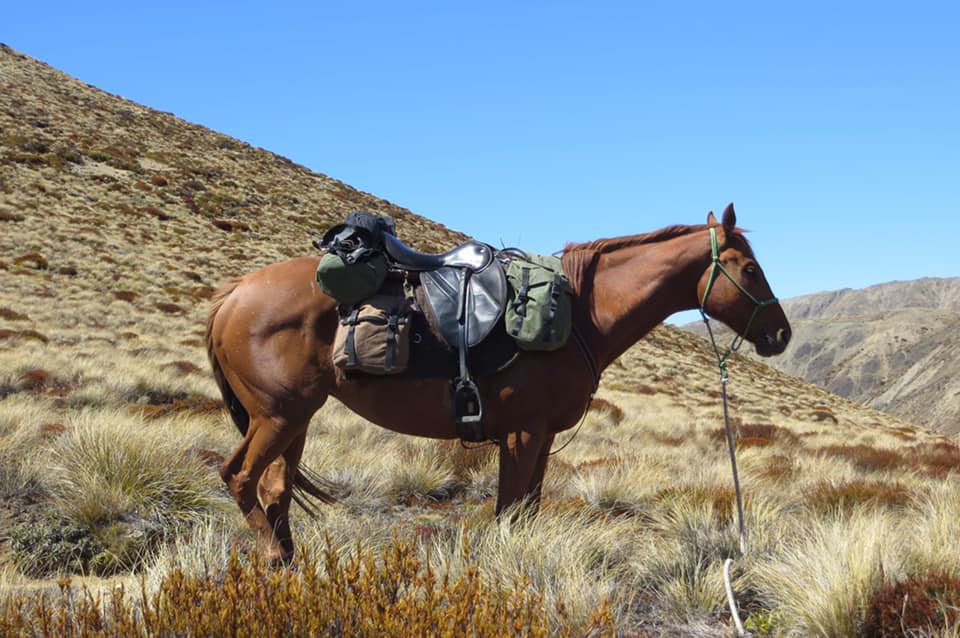
Saddle Blankets cont.
Many saddle blankets are quite short and have a nice beaded seam around them. These cause friction or pressure rubs at the back of the saddle and don’t allow extra padding for saddle bags to keep them off the horse’s spine.
Make sure your pad is long enough to accommodate saddle bags front and rear, or have an extension you can put on it with little ties for longer rides. Also check when you pack your saddlebags that sharp or heavy items go in the front packs on the bottom, not next to the horse’s skin over its loins.
Girth Galls and Rubs
Girth galls are the most common debilitating thing that can happen on a multi day trek, so make sure your girth is clean, smooth and isn’t causing any rubbing issues at this time. Like a blistered heel, a girth gall can really ruin a good trek.
Girths should be made from anti-gall material, cotton or leather. Leather requires cleaning and oiling regularly to be safe. Canvas girths are also popular but they can rot and break quite easily.
Contoured girths are good for more thoroughbred type horses with not a lot of elbow space. A little glide or lubricating gel around the elbow area is recommended for thin skinned horses.
Make sure you wash and clean girth and saddle areas every night on a trek.

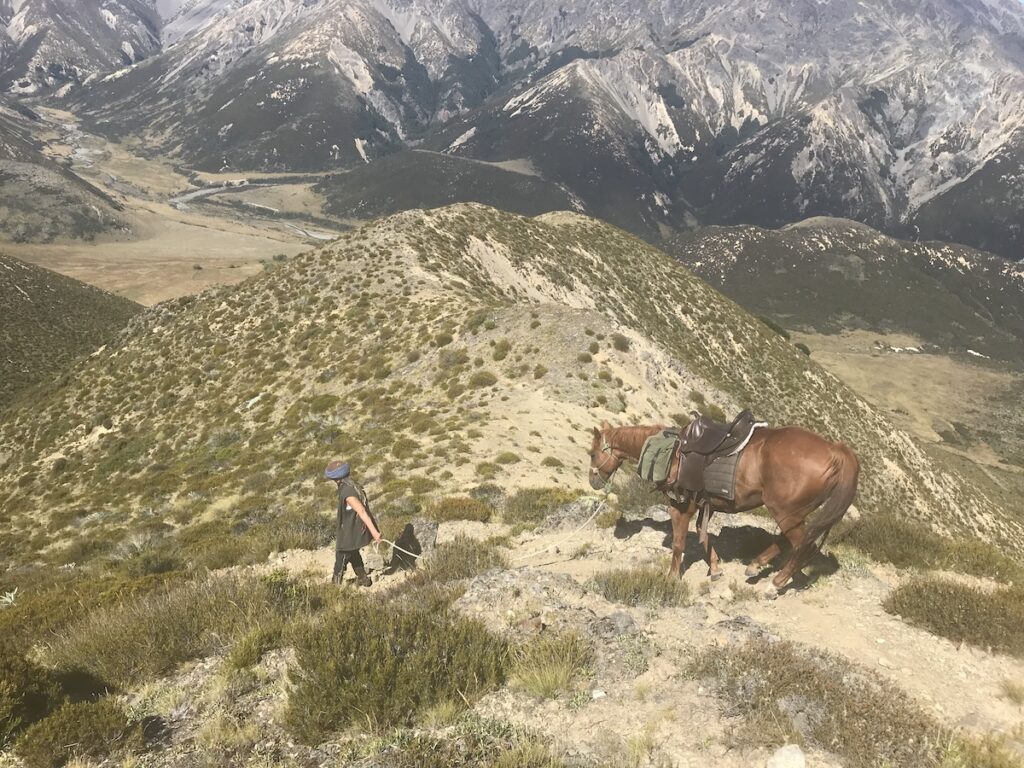
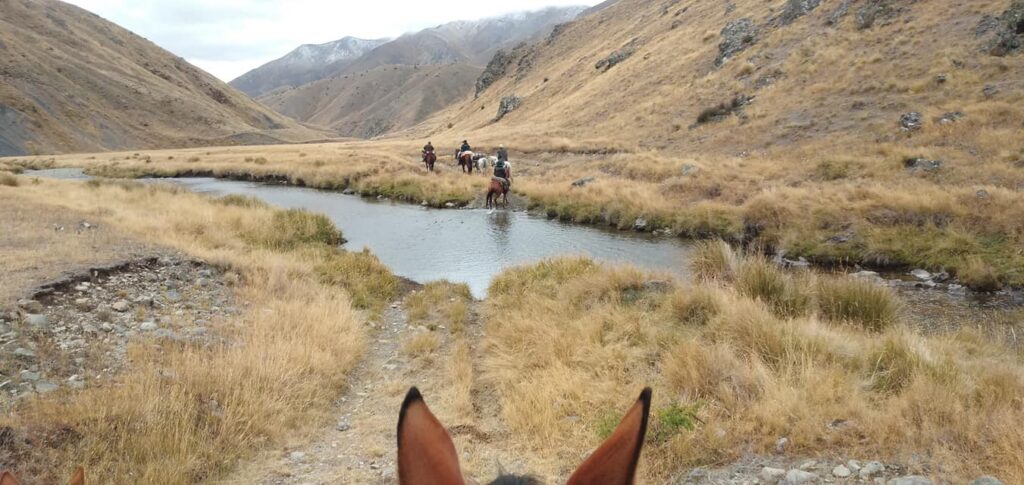
Skill Training
If you have not been in the high country before, it is valuable to do some skills training with your horse in advance. This makes it safer and more enjoyable for both of you. Here’s some skills to practice:
- river crossings
- traversing ditches without jumping
- dealing with boggy or very rocky ground without panicking
- crossing bridges and boardwalks
- pushing through spiky plants and passing under low branches
- trailing down hills (where the horse follows you at a distance – see picture)
- stepping up and down banks
- standing still to be mounted
- standing still whilst you take a jacket off and on, or eating from a packet that rustles
Shoes and Boots
Most routes require rough river travel, so most horses will require shoes or boots. Make sure your horse is recently shod because the conditions on the tracks can make it more likely to lose a shoe than riding at home.
Hoof boots are another alternative but make sure you have done plenty of hours in your boots to make sure they are a good fit and don’t rub, chaffe or rotate when wet. Boots can be easily lost on river crossings and going through bogs.
Carry a spare/emergency boot or a single use plaster-of-paris pack for if you lose a shoe.


Horse First Aid
Carry a first aid kit in case of injury: sticky bandage and cotton wool, wound cream and some packets of Bute are useful.
Some people like to take arnica tablets and cream, rescue remedy, apis homeopathic for bee stings if anyone allergic and Condies Crystals (tiny amounts added to water make a great iodine treatment for any cuts, rashes, burns etc).
Covers & Dealing with Flies
Depending on the season and where you are going, covers can be a blessing. Sandflies are pretty voracious in the high country and a stressed horse walking all night doesn’t make for an energetic partner the next day, plus rips weight off quickly.
Cold blooded horses don’t seem to mind so much but lighter breeds appreciate the protection of a bug sheet. Some people use lycra bodysuits which cover face and body and are really easy to transport. Cotton sheets or lightweight summer rainsheets are also not difficult to pack.
Stanleyvale and some of the more popular destinations have a pile of winter rugs stored in the woodsheds for the odd rough night out.
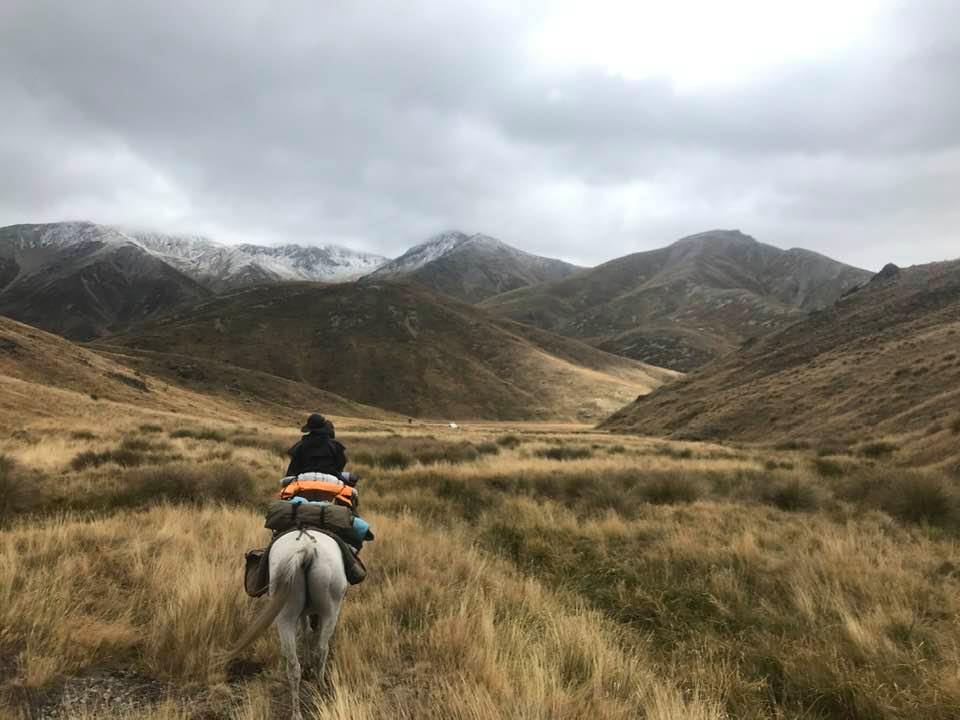

Horse Feed
Most popular huts have paddocks with a reasonable amount of grazing. It’s wise to stop for 15 mins on your journeys 2 or 3 times a day to give horses chance to pick on some nice patches of grass as you come across them.
Sometimes in mid summer the paddocks may get grazed out on the popular routes. Oats or a little horse muesli is often a good idea for a small feed at night, particularly if you are trekking in higher country with little productive grazing available. Taking a packhorse on longer rides in drier alpine country is recommended so you can take extras like feed, fencing, tents and covers.
Trekking Gear List
This list has been developed from years of personal experience.
Personal
First Aid and Essentials:
- Cut-off toothbrush and squeezed out paste in a ziplock bag
- Sun-cream/moisturizer mini
- Comb
- Soap
- Glasses (optional)
- Sun-glasses
- Plasters
- Sterile pads
- Gladwrap for under the bandages so the wound does not rip open when taking the bandage off
- Bandages (horse /human)
- Painkillers
- Savlon
- Zinc paste for sore and rough spots, e.g. Sudocrem
- Antibacterial spray for horses
- Wound powder (black charcoal stuff)
- Bute for horses
- Small syringe for the Bute/ and apple sauce if you need it to get the Bute in
- Vet wrap and iodine wash
- Insect repellent for horse (wee bottle and sponge)
- Spare batteries
- Candles and waterproof matches or fire steel rod with striker (matches also included under Food Gear below)
Wear:
- Riding pants
- Padded bike pants underneath to prevent sore bum (optional)
- 2 T-shirts, polo neck if you want to keep sun off your neck
- Warm sweater, tied around waist
- Socks
- Chaps
- Boots
- Helmet or other (we adapt our helmets with a sun hat brim) The brim with a bendable wire are good, because you can fold back your brim in strong winds.
Have nearby:
I roll swanni, parka and overtrousers with gloves and hats in the pockets, and tie on the front of my saddle for quick easy access
- Swandri
- Wooly hat
- Gloves
- Waterproof parka or Drizabone
- Waterproof overtrousers
Carry spare in waterproof bag:
- Polyprop leggings
- Top
- Gloves
- Underwear
- Spare socks
Carry in a bum bag:
- EPIRB or PLB (Personal Locator Beacon). VERY IMPORTANT – also see information about ‘High Country Trekking Safety”
- Headlamp and spare batteries or a solar powered Luci Light lantern
For example from https://www.equipoutdoors.co.nz/luci-outdoor-2.0-solar-lantern or Hunting and Fishing
- Camera
- Maps
- Chapstick
- Insect Repellent
- Snacks for you and treats for your horse
- First aid (as above)
Food and Gear
Cooking gear:
- Pot scrub and detergent squeezed into a zip lock bag
- Bowl or plat
- Sharp knife, fork, spoon
- Cup (good tied onto saddle for lunchtime drinks from the river)
- Matches – waterproof or fire steel rod
- Cooker
- Fuel
Food:
This is my personal food list – I tend to travel light, but others will share their ideas with you. It depends on how long the trip or if you have a pack horse or not.
- Oats and salt or muesli for breakfast
- Tea and fancy coffee for a treat
- Miso or other cup-of-soup sachets
- Wraps and celery, hummus and cheese etc. for lunch
- Dinner for each night (dry or fresh, depends on the trip)
- A wee tipple
- Biscuits
- Cheese, the harder the longer it lasts
- Nuts
- Emergency food pack for 1 or 2 days more than you are needing – just in case
Sleeping:
- Warm sleeping bag and liner
- Waterproof bed roll or light bivvy bag
- Ground pad
- Tent (optional – see page on Huts and Paddocks in St. James)
Multi day treks:
- Bolt cutters for emergency
- Fold up saw
On your horse:
- Saddle and thick pads
- Bridle
- Collar or halter
- Tether rope (at least 8 foot, 2.5m )
- Fly cover (optional)
- Long rope for high lining if there are no paddocks (see page on Huts and Paddocks in St. James)
It might be nice to take some entertainment for rainy days, like book, puzzle book, Sudoku, paint, brush and paper, pencil, wood carving tool…